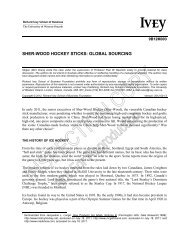foundation of canada asia pacific - Content Tagged with
foundation of canada asia pacific - Content Tagged with
foundation of canada asia pacific - Content Tagged with
Create successful ePaper yourself
Turn your PDF publications into a flip-book with our unique Google optimized e-Paper software.
enabled Canada to take a stronger role in advancing its policy <strong>of</strong> promoting security<br />
and cooperation in Asia. The most important event was our participation in the East<br />
Timor independence process. Canada assisted in the transition by providing personnel<br />
to the United Nations to help supervise the elections in the summer, then contributed<br />
more than 600 military personnel to the UN-sanctioned peacekeeping forces in the newly<br />
independent territory. Aiding Canada’s performance in this area was its role as an elected<br />
member <strong>of</strong> the UN Security Council during 1999-2000 and its continued involvement<br />
in informal “Track II” security initiatives in both North and Southeast Asia.<br />
The only other area where we felt able to award a slightly improved grade was in the<br />
category <strong>of</strong> education, which has been redefined from last year (when it also included<br />
“culture,” now part <strong>of</strong> Canada’s Image in Asia). Asian student interest in Canada is<br />
recovering from the downturn <strong>of</strong> the Asian crisis. The number <strong>of</strong> applications for student<br />
visas was up considerably from countries which suffered most during the meltdown.<br />
Even more impressive was the increase in the number <strong>of</strong> visas granted. China alone<br />
posted a staggering 206% growth in the number <strong>of</strong> visas granted between the first nine<br />
months <strong>of</strong> 1998 and the similar period <strong>of</strong> 1999.<br />
17<br />
Offsetting these improvements was a disappointing performance, and hence lower grade,<br />
in the important area <strong>of</strong> trade. Our performance deteriorated by almost any measure —<br />
exports, total trade, marketshare (the proportion <strong>of</strong> Canadian products in total Asian<br />
imports), or the proportion <strong>of</strong> manufactured goods in our exports. The value <strong>of</strong> exports<br />
during the first nine months <strong>of</strong> 1999 was down 7% from the same period <strong>of</strong> 1998. Over<br />
the period <strong>of</strong> the Asian crisis Canada’s exports to Asia Pacific have fallen proportionately<br />
much more than those <strong>of</strong> the US or Australia. Our marketshare <strong>with</strong> our top ten Asian<br />
customers continued to decline steadily, to less than 1% in the first quarter <strong>of</strong> 1999<br />
compared <strong>with</strong> 1.4% in the same months <strong>of</strong> 1998 and 1.36% for all <strong>of</strong> 1998. The proportion<br />
<strong>of</strong> commodities and unprocessed products in the mix edged above 70% for 1999.<br />
There was insufficient improvement or deterioration in the six other rated areas <strong>of</strong> our<br />
relationship to vary the grades from last year’s levels. Three categories are the subjective<br />
areas <strong>of</strong> “awareness,” “image” and “projection <strong>of</strong> values.” Canadian awareness <strong>of</strong> Asia can<br />
be most readily measured by examining media coverage <strong>of</strong> the region, so our category this<br />
year has been redefined to reflect this. While the quantity <strong>of</strong> coverage last year matched<br />
the increased volume <strong>of</strong> the past few years, it still appears to be driven by sensational<br />
developments in Asia rather than any reassessment <strong>of</strong> the importance <strong>of</strong> the region.<br />
Coverage continued to be sporadic, as the focus <strong>of</strong> crisis or calamity moved from country<br />
to country, rarely providing continuing news to place the events in context. The exceptions<br />
were Indonesia and East Timor. Building on the detailed coverage <strong>of</strong> Suharto’s fall in<br />
1998 (which media had been able to tie in to the domestic Canadian saga <strong>of</strong> the APEC<br />
inquiry), coverage, including first-hand reporting by Canadian journalists, was extensive.<br />
As the East Timor crisis came to a head, the dispatch <strong>of</strong> Canadian peacekeepers provided<br />
the domestic interest to keep media attention focused. Overall, however, there was no<br />
real change from the quantity or style <strong>of</strong> coverage <strong>of</strong> the previous year, so the grade<br />
remains unchanged.



